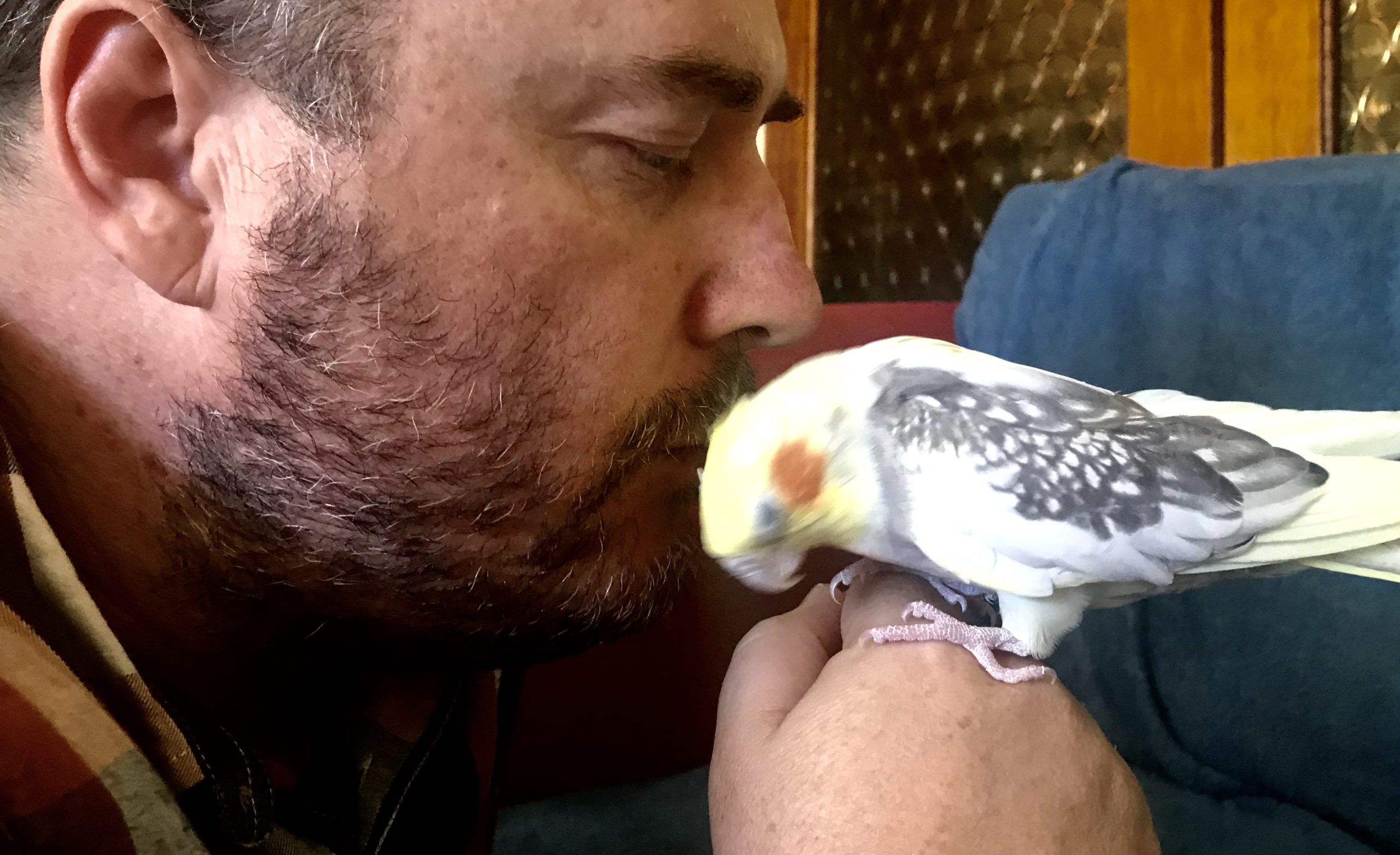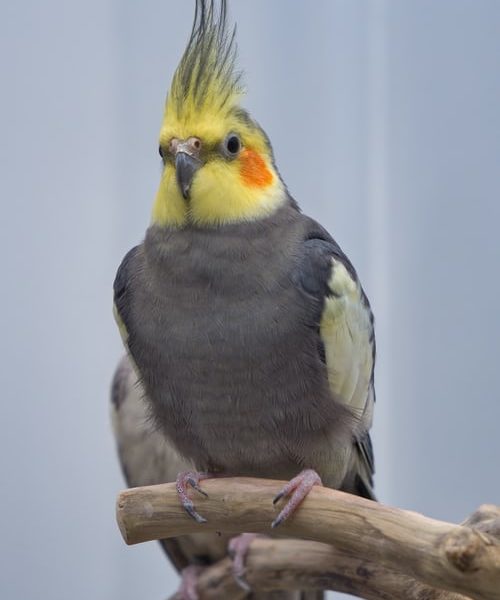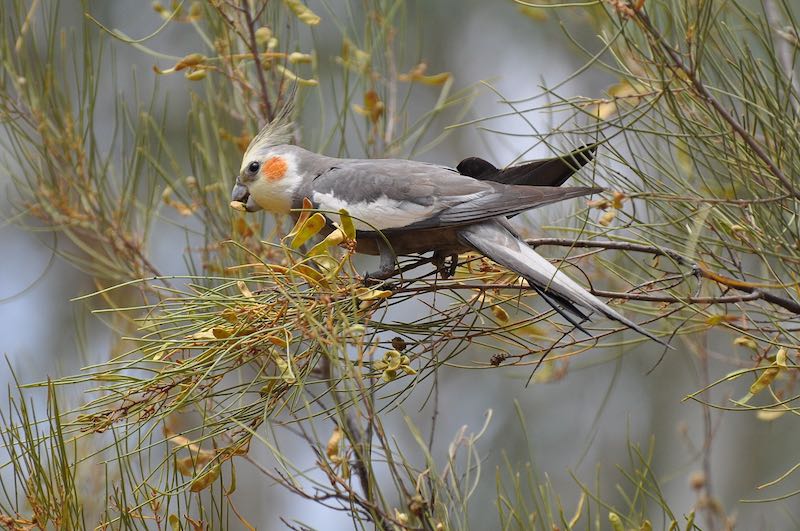Although it is easier to tame a young bird, with a bit of patience and care, you can tame an older cockatiel. Firstly, get your older cockatiel used to the new environment, talk calmly and gently and get him used to you being near the cage. When the time is right, start hand feeding your cockatiel through the cage, near the opening of the cage and teach your bird to step up. Depending on the cockatiels history and personality, you may not achieve all these steps. Achieving just a few will be beneficial for you and your bird. Each bird is a little different and observing your cockatiel as you train him and using your common sense will direct you in how quickly to move through the steps.
Below are the 7 steps to train your older cockatiel. But first a question that comes up often is, should I clip my cockatiels wings when training him?
Should I Clip My Cockatiels Wings When Training
There’s no definitive answer on whether you should clip your cockatiels wings. It is much easier to ‘tame’ your bird if you do clip their wings, or perhaps I should say it’s much easier to get them to do what you want them to do. If your cockatiel can’t fly, you can force the bird to stay on your hand, more easily get the bird out of his cage or back in his cage. The bird in this case must rely on you to get around and of course won’t fly away when you are training it.
Clipped birds can sit on a perch outside their cage more often and the risk of flying out a window or the door is gone. They are less likely to hurt themselves flying around the house or cage too.
Others say, that birds were created to fly and it is cruel to take that away from them. The act of clipping their wings, especially for an untamed bird, can be traumatic and might set you back in gaining their trust. Some birds may feel less safe if unable to fly away when they want to.
Our pet cockatiel ‘Nebbel’ does not have her wings clipped and will sit on our shoulder and fingers no problem. She flies on command to get a tasty treat too. Sometimes, though it is hard to get her back in the cage and once she got out! She was missing for 3 months!
So, anyway I have given tips for taming your older cockatiel based on not cutting your birds wings.
1. Getting the Older Cockatiel Used to the New Environment
When you first bring your ‘new’ older cockatiel home keep in mind that everything is new for your bird. The sounds, the smells, the sights, the colours. Everything is different and apart from being shy from you, your bird is just trying to take everything in and wondering what is going to happen next.
Firstly, be patient. Taming any cockatiel, especially an older one won’t happen in a day.
Find a spot in the house to put the cage that has people around but that isn’t too noisy and busy. It will take a bit of time for your bird to get used to their new cage and surroundings, but they will.
2. Talk Calmly, gently and consistently when taming your older cockatiel
From day one, talk calmly and gently with your bird throughout the day. Perhaps even being intentional about some of the phrases you speak. The most important thing here is talking calmly and gently.
After a few days or when you think the time is right, start to move closer to the cage. Do this slowly, without any fast or drastic movements. Even tame birds will get spooked by drastic and sudden moves.
Each day keep moving closer and continue speaking gently. Little whistles are great too.
When your older cockatiel stops hissing or lunging at you, your bird is probably ready for the next step.
3. Hand Feeding Through the Cage
Find out what your cockatiel loves to eat and see if you can hand feed your bird through the cage. The cage is your birds safe place, so starting the training with you outside of the cage can help the older cockatiel to feel safe as you bond. Millet Spray is a great treat for this step as cockatiels generally love it and it can be a bit further away from the hand.
You may be able to go with something like sunflower seeds after that.
4. Hand Feeding Near the Opening of the Cage
Once your bird is used to coming over to your hand to be fed through the cage, you are ready for this next step. If you can get your older cockatiel used to coming over to the opening of the cage and be fed there with the cage still shut, you are one step closer to having a tame cockatiel. You may want to put a small perch there to make it easy for your cockatiel to get there.
Now that your bird is happy to come over to you near the opening of the cage, open the cage just a little and continue doing the same. Over time you should be able to open the cage door wide open.
5. Stepping Up
The next step is to see if your cockatiel will step on to your hand to come and get the treat. I find that a flat hand with the thumb tucked away is less scary than a finger. Hold your hand out kind of making a little perch at the front of the cage with the treat held in the other hand. Do this many times until your bird is more than happy to hop on your hand.
You don’t want to rush any steps, especially this one. If you bring your bird out of the cage and the wings are not clipped, you may find it very hard to get your cockatiel back in the cage if they are not used to hoping on your hand.
We usually say the phrase ‘step up’ when our cockatiel hops on our hand or finger. That way she associates that word over time with hopping on our hands. Eventually you will be able to go to your bird and lightly press on their breast and say ‘step up’ and the bird will know what to do.
Be aware that cockatiels do bite and it can have a bit of a sting if they bite down hard. Of course, we don’t want to encourage biting but be careful not to lose trust when reacting to being bitten.
6. Take out of the Cage
Once the bird is more than happy to step onto your hand for a treat and stay there for a while, you are ready to bring the bird out of the cage.
Just like all the steps, don’t rush this and start with just going a small distance from the cage. Make sure all the windows and doors are shut! It’s also a good idea to half close the blinds. If your cockatiel goes for a bit of fly, he probably doesn’t know that shut windows hurt when crashing into them.
7. Scratch
This step is perhaps not that likely with an older cockatiel. Hand raised cockatiels love a good scratch around their head and neck and with patience and moving very slowly you maybe able to start scratching your bird on their head.
Even if you get to step 4 or 5, your bird will be much happier and less scared of you if you are able to tame your older cockatiel to some extent.
Here’s a couple of videos on YouTube where people tamed an older cockatiel.
How to tame a wild cockatiel easily
Another video with a different approach to me
Let us know how you have gone with taming your older cockatiel in the comments below.
Chat soon,
Glenn.



